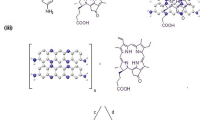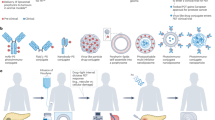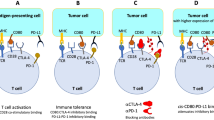Abstract
The covalent binding of a carotene moiety to one phenyl ring and meso-tetraphenyl-substituted porphyrins (see Figure 1) efficiently quenches the photosensitising activity of the porphyrin while a relatively large yield of fluorescence emission around 650 nm is retained. Pharmacokinetic studies performed with two carotenoporphyrins (CPs) and the corresponding porphyrins (Ps) in Balb/c mice bearing an MS-2 fibrosarcoma show that the two Ps give a high selectivity of tumour localisation (tumour/peritumoral tissue ratios of dye concentration ranging between c. 30 and 90 at 24 h after injection of 4.2-8.4 mumol kg-1 in a Cremophor emulsion) and photosensitive tumour necrosis upon red light irradiation. For the same injected doses, the two CPs show no tumour-photosensitising activity even though they localise in the tumour in concentrations of the order of 10-40 micrograms g-1 at 24 h with tumour/peritumoral ratios larger than 10. Thus, the fluorescence emitted by these CPs in the tumour can be used for photodiagnostic purposes with no risk of skin photosensitisation. However, this approach is presently limited by the large accumulation and prolonged retention of the CPs in the liver and spleen.
This is a preview of subscription content, access via your institution
Access options
Subscribe to this journal
Receive 24 print issues and online access
$259.00 per year
only $10.79 per issue
Buy this article
- Purchase on SpringerLink
- Instant access to full article PDF
Prices may be subject to local taxes which are calculated during checkout
Similar content being viewed by others
Author information
Authors and Affiliations
Rights and permissions
About this article
Cite this article
Reddi, E., Segalla, A., Jori, G. et al. Carotenoporphyrins as selective photodiagnostic agents for tumours. Br J Cancer 69, 40–45 (1994). https://doi.org/10.1038/bjc.1994.6
Issue date:
DOI: https://doi.org/10.1038/bjc.1994.6
This article is cited by
-
Hematoporphyrin-mediated fluorescence reflectance imaging: application to early tumor detection in vivo in small animals
Lasers in Medical Science (2009)
-
Developments Toward Diagnostic Breast Cancer Imaging Using Near-Infrared Optical Measurements and Fluorescent Contrast Agents1
Neoplasia (2000)
-
Influence of tumour depth, blood absorption and autofluorescence on measurements of exogenous fluorophores in tissue
Lasers in Medical Science (1998)
-
Tumor labeling in vivo using cyanine-conjugated monoclonal antibodies
Cancer Immunology Immunotherapy (1995)



